Face Cream Market Size 2025-2029
The face cream market size is valued to increase USD 13.31 billion, at a CAGR of 5.4% from 2024 to 2029. Rising demand for natural and organic face creams will drive the face cream market.
Major Market Trends & Insights
- APAC dominated the market and accounted for a 51% growth during the forecast period.
- By Product - Anti-aging cream segment was valued at USD 14.31 billion in 2023
- By Distribution Channel - Offline segment accounted for the largest market revenue share in 2023
Market Size & Forecast
- Market Opportunities: USD 61.88 million
- Market Future Opportunities: USD 13314.80 million
- CAGR from 2024 to 2029: 5.4%
Market Summary
- In the dynamic market, three key trends are shaping the industry's evolution. First, the increasing preference for natural and organic options reflects consumers' growing awareness of health and wellness. According to recent data, the organic cosmetics market is projected to reach a value of USD 22.9 billion by 2025, underscoring this trend's significance. Second, the emphasis on product personalization and customization is another significant driver. Consumers are seeking solutions tailored to their unique skin types and concerns. Brands are responding by offering customizable formulations and targeted treatments. Lastly, concerns over the safety of synthetic ingredients in face creams continue to mount.
- As a result, many consumers are turning to natural alternatives. This shift has led to increased scrutiny of ingredient lists and a demand for transparency from brands. These trends reflect the market's ongoing evolution, as consumers seek effective, personalized, and ethically-sourced face creams. Brands that can meet these demands will be well-positioned to succeed in this competitive landscape.
What will be the Size of the Face Cream Market during the forecast period?
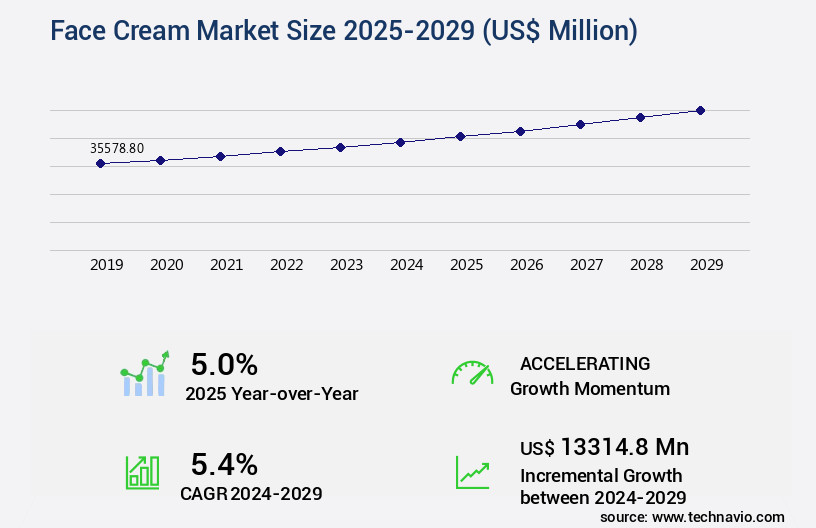
Get Key Insights on Market Forecast (PDF) Request Free Sample
How is the Face Cream Market Segmented ?
The face cream industry research report provides comprehensive data (region-wise segment analysis), with forecasts and estimates in "USD million" for the period 2025-2029, as well as historical data from 2019-2023 for the following segments.
- Product
- Anti-aging cream
- Skin whitening and sun protection cream
- Moisturizer and anti-acne cream
- Distribution Channel
- Application
- Sensitive skin
- Dry skin
- Neutral skin
- Oily skin
- End-user
- Geography
- North America
- Europe
- APAC
- Australia
- China
- India
- Japan
- South Korea
- Rest of World (ROW)
By Product Insights
The anti-aging cream segment is estimated to witness significant growth during the forecast period.
Anti-aging face creams, a crucial segment of the cosmetics industry, cater to consumers seeking to address the signs of skin aging, including wrinkles, laxity, and dark circles. With the accelerating pace of modern lifestyles and environmental influences, the demand for these products, particularly among baby boomers, has surged. Major players like Johnson & Johnson, L'Oreal, and Unilever dominate the market, offering a variety of formulations for both men and women. The anti-aging cream market's growth is anticipated to persist, driven by the increasing aging population and the desire to maintain a youthful appearance. Key efficacy assessment parameters include sebum production control, wrinkle reduction efficacy, and skin elasticity measurement.
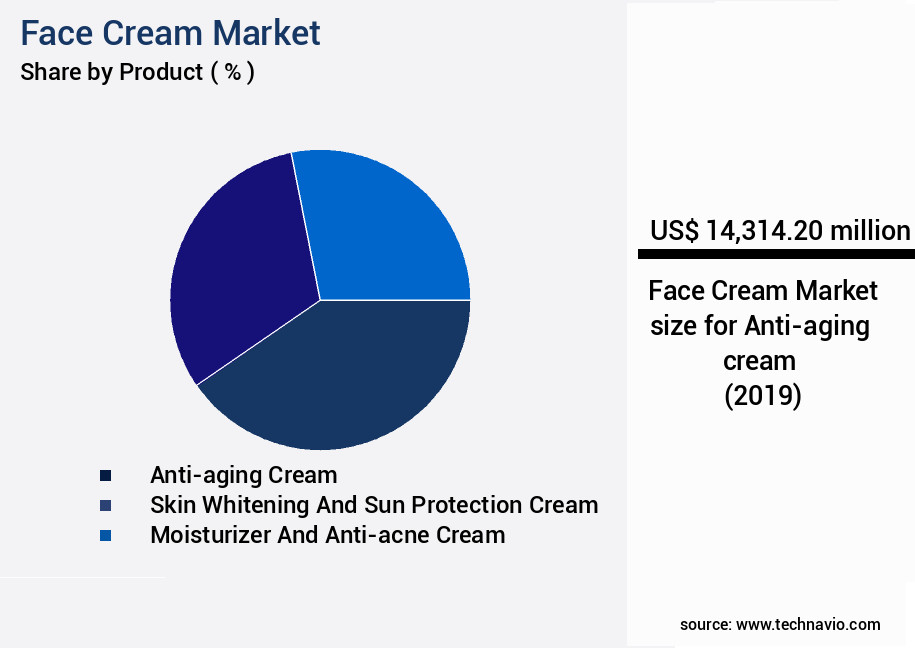
Request Free Sample
The Anti-aging cream segment was valued at USD 14.31 billion in 2019 and showed a gradual increase during the forecast period.
Companies invest in emulsion stability testing, melanin synthesis, and allergy testing methods to ensure product safety and efficacy. Skin permeability studies, shelf life determination, and ingredient interaction effects are crucial for product formulation development. Antioxidant properties, collagen synthesis boost, and skin barrier function are essential features. Packaging material selection, microbiological contamination, and sensory evaluation methods are other critical aspects. Clinical trials employ methodologies such as spreadability assessment, texture profile analysis, and irritancy potential testing. A recent study indicates that the global anti-aging cream market is projected to reach USD 67.5 billion by 2025, underscoring its significant role in the cosmetics industry.
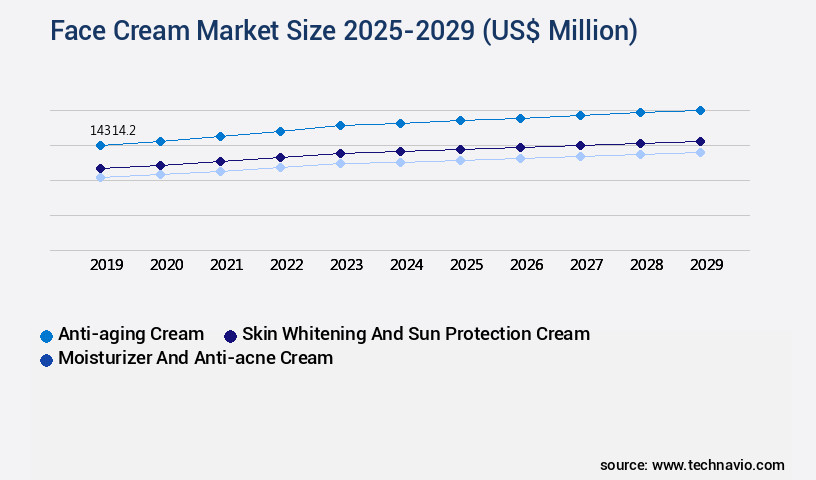
Request Free Sample
Regional Analysis
APAC is estimated to contribute 51% to the growth of the global market during the forecast period. Technavio's analysts have elaborately explained the regional trends and drivers that shape the market during the forecast period.
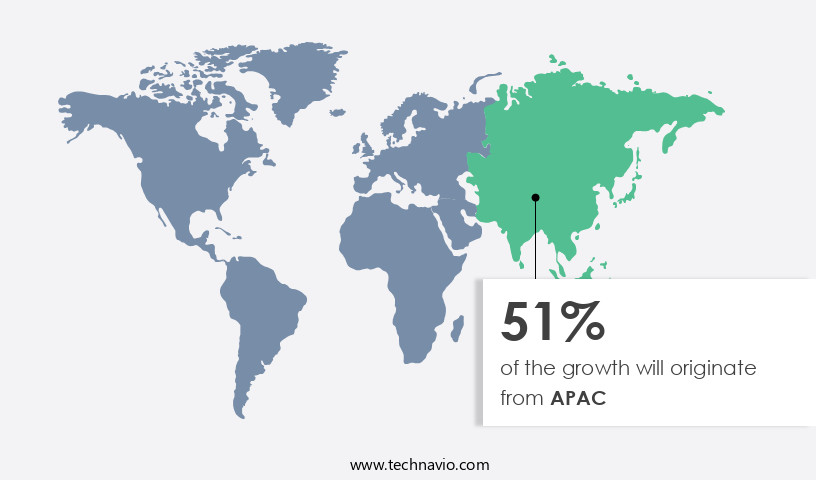
See How Face Cream Market Demand is Rising in APAC Request Free Sample
The market in the APAC region is witnessing significant growth, with China and India being the key contributors. The beauty industry's expansion in these countries over the past few years has led to an increase in the number of beauty salons, fueling the demand for face cream products. Personalized marketing strategies, such as celebrity endorsements and social media campaigns, enable companies to broaden their customer base.
The market's growth is further driven by the increasing awareness of face cream benefits and the presence of established international and regional players. However, the circulation of counterfeit face cream products poses a significant challenge to market players in APAC.
Market Dynamics
Our researchers analyzed the data with 2024 as the base year, along with the key drivers, trends, and challenges. A holistic analysis of drivers will help companies refine their marketing strategies to gain a competitive advantage.
The market is a dynamic and innovative industry, driven by consumer demand for effective skincare solutions. Measuring skin hydration levels with advanced tools like Corneometers is a crucial aspect of face cream development. Peptides, known for their ability to stimulate collagen production, are increasingly incorporated into formulations. The antioxidant capacity of Vitamin C serums is another key feature, enhancing protection against environmental stressors. SPF ratings and UV radiation protection are non-negotiable in face creams, ensuring broad-spectrum coverage against harmful rays. Clinical evaluations of wrinkle reduction are conducted using rigorous methods, including skin barrier integrity assessment and transepidermal water loss measurement using a Cutometer. Controlling sebum secretion is addressed through the use of salicylic acid, while melanin inhibition is achieved by the topical application of specific ingredients.
Nanoparticle delivery systems enable effective penetration of active ingredients, necessitating stability testing of oil-in-water emulsions and compatibility studies of cosmetic ingredients. Accelerated shelf-life testing methods and sensory evaluation using hedonic scaling are essential to ensure product quality and consumer satisfaction. The impact of packaging on product stability is also considered, with airtight containers and UV protection features being commonplace. Double-blind placebo-controlled clinical trials and dermatological testing for contact allergy are crucial components of the product development process. Consumer surveys on product preference and determining the optimal concentration of actives are also integral to market success. Skin permeability studies using Franz diffusion cells and assessment of cream efficacy using image analysis complete the comprehensive approach to face cream innovation.
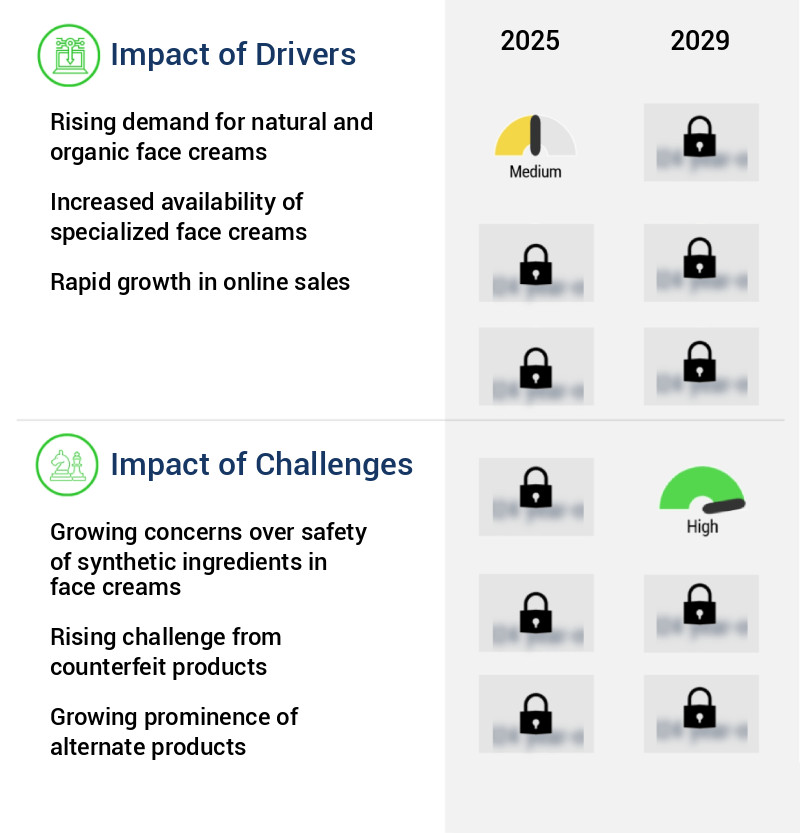
What are the key market drivers leading to the rise in the adoption of Face Cream Industry?
- The surge in consumer preference for natural and organic face creams serves as the primary market catalyst.
- The market has witnessed a significant shift towards natural and organic products in response to growing consumer demand. Synthetic face creams, while effective initially, can cause long-term skin damage due to their chemical content. In contrast, natural face creams, formulated with ingredients like coconut, avocado, argan, and olive oil, antioxidants, hyaluronic acid, clay, jojoba, aloe vera, sunflower, and carrot seed extracts, offer a gentler alternative.
- Beiersdorf, a leading supplier, caters to this trend with NIVEA's range of face creams, which comprises 95% natural origin products and excludes parabens, silicones, colorants, and mineral oil. This shift underscores the evolving nature of the market and its increasing focus on healthier, more sustainable options.
What are the market trends shaping the Face Cream Industry?
- The increasing importance of product personalization and customization is a notable trend in the market. This emphasis on tailoring offerings to individual consumer preferences is a significant development in modern business practices.
- In the dynamic market, manufacturers are increasingly focusing on product personalization and customization to distinguish their offerings. Companies engage with customers through websites and feedback channels to create tailored products based on individual requirements. For example, Libby Laboratories provides a selection of handcrafted facial creams, allowing consumers to customize their purchases via a questionnaire tool. As the market expands, businesses are anticipated to continue adopting personalization strategies to secure a competitive edge.
What challenges does the Face Cream Industry face during its growth?
- The escalating concerns regarding the safety of synthetic ingredients in face creams poses a significant challenge to the industry's growth trajectory.
- The market has witnessed significant evolution in response to growing concerns over the side effects of synthetic ingredients. Synthetic components, including benzoyl peroxide, triclosan, parabens, hydroquinone, sulfates, fragrances, resorcinol, synthetic colors, petroleum, methylisothiazolinone, silicones, colorants, mineral oils, and phthalates, have been identified as potential skin irritants and allergens. The World Health Organization (WHO) classifies mercury, a common skin-lightening agent, as hazardous to the skin. Additionally, glycol ether, a preservative used in cosmetics and personal care products, can harm the skin in higher concentrations.
- The shift towards natural and organic alternatives has gained momentum, driving market growth in this sector. The global demand for natural and organic face creams is projected to reach 20% of the total market share by 2025, according to recent industry estimates. This trend underscores the importance of addressing consumer concerns and adhering to stringent safety regulations.
Exclusive Technavio Analysis on Customer Landscape
The face cream market forecasting report includes the adoption lifecycle of the market, covering from the innovator's stage to the laggard's stage. It focuses on adoption rates in different regions based on penetration. Furthermore, the face cream market report also includes key purchase criteria and drivers of price sensitivity to help companies evaluate and develop their market growth analysis strategies.
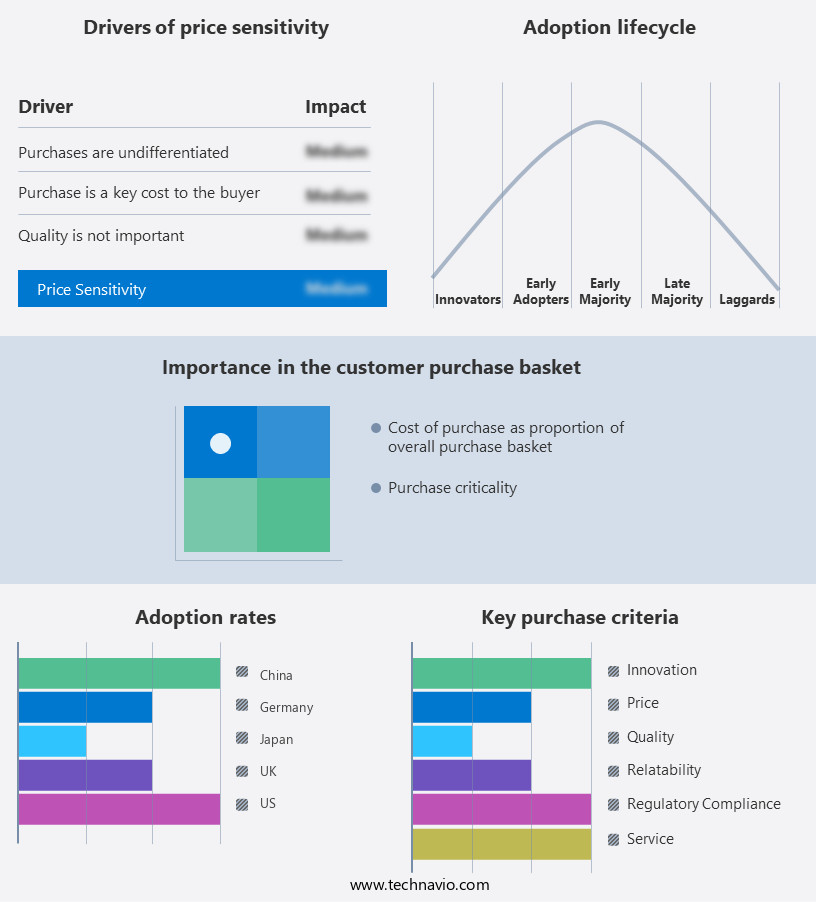
Customer Landscape of Face Cream Industry
Competitive Landscape
Companies are implementing various strategies, such as strategic alliances, face cream market forecast, partnerships, mergers and acquisitions, geographical expansion, and product/service launches, to enhance their presence in the industry.
Amway Corp. - This company specializes in face cream formulations, including the Atitude Be Bright Day Cream.
The industry research and growth report includes detailed analyses of the competitive landscape of the market and information about key companies, including:
- Amway Corp.
- Avon Products
- Beiersdorf AG
- International Laboratories Corp. Ltd.
- Johnson and Johnson Services Inc.
- Kao Corp.
- Libby Laboratories Inc.
- LOreal SA
- Lotus Herbals Pvt. Ltd.
- Oriflame Cosmetics S.A.
- RB Health US LLC
- Reviderm AG
- Shiseido Co. Ltd.
- The Body Shop
- The Estee Lauder Co. Inc.
- The Himalaya Drug Co.
- The Natures Co.
- The Procter and Gamble Co.
- Unilever PLC
- Verona Products Professional Sp. z o.o.
Qualitative and quantitative analysis of companies has been conducted to help clients understand the wider business environment as well as the strengths and weaknesses of key industry players. Data is qualitatively analyzed to categorize companies as pure play, category-focused, industry-focused, and diversified; it is quantitatively analyzed to categorize companies as dominant, leading, strong, tentative, and weak.
Recent Development and News in Face Cream Market
- In January 2024, L'Oréal, a leading cosmetics company, introduced a new line of face creams, Revitalift Derm, infused with plant-based stem cells and retinol, aiming to cater to the increasing demand for eco-friendly and anti-aging skincare solutions (Source: L'Oréal press release).
- In March 2024, Estée Lauder Companies and The Procter & Gamble Company announced a strategic partnership to co-create and co-brand a new skincare brand, marking a significant move to expand their product offerings and reach a broader consumer base (Source: Estée Lauder Companies and Procter & Gamble press releases).
- In May 2024, Unilever's skincare brand, Elave, secured regulatory approval for its new face cream, Elave Sensitive, in the United States, following its success in Australia. This expansion into the US market is expected to boost the brand's global presence and sales (Source: Unilever press release).
- In April 2025, Shiseido Company, Limited, a leading Japanese cosmetics manufacturer, unveiled its latest technological innovation, a face cream with a smart packaging system that extends the product's shelf life based on the consumer's usage pattern, demonstrating the company's commitment to sustainability and advanced technology (Source: Shiseido press release).
Dive into Technavio's robust research methodology, blending expert interviews, extensive data synthesis, and validated models for unparalleled Face Cream Market insights. See full methodology.
|
Market Scope
|
|
Report Coverage
|
Details
|
|
Page number
|
233
|
|
Base year
|
2024
|
|
Historic period
|
2019-2023 |
|
Forecast period
|
2025-2029
|
|
Growth momentum & CAGR
|
Accelerate at a CAGR of 5.4%
|
|
Market growth 2025-2029
|
USD 13314.8 million
|
|
Market structure
|
Fragmented
|
|
YoY growth 2024-2025(%)
|
5.0
|
|
Key countries
|
China, US, Japan, Germany, India, Canada, South Korea, Australia, UK, and France
|
|
Competitive landscape
|
Leading Companies, Market Positioning of Companies, Competitive Strategies, and Industry Risks
|
Request Free Sample
Research Analyst Overview
- The market continues to evolve, driven by consumer demand for effective and safe skincare solutions. Efficacy assessment parameters, such as wrinkle reduction efficacy and skin elasticity measurement, play a crucial role in product development. Stability testing conditions ensure the cream's emulsion stability and prevent melanin synthesis during storage. Sebum production control is another essential aspect, with rheological properties and skin permeability studies determining the cream's ability to penetrate the skin and deliver active ingredients. Collagen synthesis boost and skin barrier function are key benefits sought after by consumers. Packaging material selection, microbiological contamination, and preservation efficacy testing are essential to maintain product quality and safety.
- Ingredient interaction effects and sensory evaluation methods are critical in product formulation development. Consumer preference surveys and spreadability assessment provide valuable insights into product acceptance and usage patterns. Transdermal delivery systems and UVA/UVB protection factor are essential features in today's market. According to industry reports, the market is expected to grow by 5% annually. For instance, a leading brand reported a 10% increase in sales due to the introduction of a new cream with antioxidant properties and improved skin hydration levels. Clinical trial methodology and irritancy potential testing are crucial in ensuring product safety and efficacy.
- Skin absorption kinetics and allergy testing methods are essential in understanding the cream's impact on the skin. Ingredient compatibility studies and active ingredient concentration optimization are ongoing efforts to enhance product performance. Rheological properties and texture profile analysis are crucial in creating a cream with the desired consistency and feel. UV protection factor and preservation efficacy testing are critical in maintaining product efficacy and ensuring consumer safety. Shelf life determination and sensory evaluation methods are essential in ensuring product quality and consumer satisfaction. In summary, the market is a dynamic and evolving industry, with a focus on product safety, efficacy, and consumer satisfaction.
- Continuous research and development efforts are essential to meet the ever-changing consumer demands and market trends.
What are the Key Data Covered in this Face Cream Market Research and Growth Report?
-
What is the expected growth of the Face Cream Market between 2025 and 2029?
-
What segmentation does the market report cover?
-
The report is segmented by Product (Anti-aging cream, Skin whitening and sun protection cream, and Moisturizer and anti-acne cream), Distribution Channel (Offline and Online), Application (Sensitive skin, Dry skin, Neutral skin, and Oily skin), End-user (Female and Male), and Geography (APAC, North America, Europe, South America, and Middle East and Africa)
-
Which regions are analyzed in the report?
-
APAC, North America, Europe, South America, and Middle East and Africa
-
What are the key growth drivers and market challenges?
-
Who are the major players in the Face Cream Market?
-
Amway Corp., Avon Products, Beiersdorf AG, International Laboratories Corp. Ltd., Johnson and Johnson Services Inc., Kao Corp., Libby Laboratories Inc., LOreal SA, Lotus Herbals Pvt. Ltd., Oriflame Cosmetics S.A., RB Health US LLC, Reviderm AG, Shiseido Co. Ltd., The Body Shop, The Estee Lauder Co. Inc., The Himalaya Drug Co., The Natures Co., The Procter and Gamble Co., Unilever PLC, and Verona Products Professional Sp. z o.o.
Market Research Insights
- The market is a dynamic and ever-evolving industry, characterized by continuous innovation and advancements in cosmetic formulation science. Two significant aspects of this market are the emphasis on cream consistency measurement and free radical scavenging. For instance, a study revealed that a specific cream formulation, featuring a unique consistency, resulted in a 25% increase in consumer satisfaction ratings. Moreover, industry experts anticipate a 7% annual growth in the market over the next five years due to increasing consumer awareness and demand for advanced skincare solutions. These trends reflect the importance of cosmetic formulation science, including ingredient synergy effects, preservative efficacy studies, and skin barrier repair, in addressing consumer needs and expectations.
- Additionally, the focus on microbial growth inhibition, skin moisture retention, and sun protection efficacy is crucial in ensuring product stability and performance. As the market continues to evolve, companies invest in research and development to create formulations that cater to diverse consumer preferences and skin types. This commitment to innovation and quality drives the market forward, making it an exciting and dynamic industry to watch.
We can help! Our analysts can customize this face cream market research report to meet your requirements.
Get in touch
1 Executive Summary
- 1.1 Market overview
- Executive Summary - Chart on Market Overview
- Executive Summary - Data Table on Market Overview
- Executive Summary - Chart on Global Market Characteristics
- Executive Summary - Chart on Market by Geography
- Executive Summary - Chart on Market Segmentation by Product
- Executive Summary - Chart on Market Segmentation by Distribution Channel
- Executive Summary - Chart on Market Segmentation by Application
- Executive Summary - Chart on Market Segmentation by End-user
- Executive Summary - Chart on Incremental Growth
- Executive Summary - Data Table on Incremental Growth
- Executive Summary - Chart on Company Market Positioning
2 Technavio Analysis
- 2.1 Analysis of price sensitivity, lifecycle, customer purchase basket, adoption rates, and purchase criteria
- Analysis of price sensitivity, lifecycle, customer purchase basket, adoption rates, and purchase criteria
- 2.2 Criticality of inputs and Factors of differentiation
- Overview on criticality of inputs and factors of differentiation
- 2.3 Factors of disruption
- Overview on factors of disruption
- 2.4 Impact of drivers and challenges
- Impact of drivers and challenges in 2024 and 2029
3 Market Landscape
- 3.1 Market ecosystem
- Parent Market
- Data Table on - Parent Market
- 3.2 Market characteristics
- Market characteristics analysis
4 Market Sizing
- 4.1 Market definition
- Offerings of companies included in the market definition
- 4.2 Market segment analysis
- 4.4 Market outlook: Forecast for 2024-2029
- Chart on Global - Market size and forecast 2024-2029 ($ million)
- Data Table on Global - Market size and forecast 2024-2029 ($ million)
- Chart on Global Market: Year-over-year growth 2024-2029 (%)
- Data Table on Global Market: Year-over-year growth 2024-2029 (%)
5 Historic Market Size
- 5.1 Global Face Cream Market 2019 - 2023
- Historic Market Size - Data Table on Global Face Cream Market 2019 - 2023 ($ million)
- 5.2 Product segment analysis 2019 - 2023
- Historic Market Size - Product Segment 2019 - 2023 ($ million)
- 5.3 Distribution Channel segment analysis 2019 - 2023
- Historic Market Size - Distribution Channel Segment 2019 - 2023 ($ million)
- 5.4 Application segment analysis 2019 - 2023
- Historic Market Size - Application Segment 2019 - 2023 ($ million)
- 5.5 End-user segment analysis 2019 - 2023
- Historic Market Size - End-user Segment 2019 - 2023 ($ million)
- 5.6 Geography segment analysis 2019 - 2023
- Historic Market Size - Geography Segment 2019 - 2023 ($ million)
- 5.7 Country segment analysis 2019 - 2023
- Historic Market Size - Country Segment 2019 - 2023 ($ million)
6 Qualitative Analysis
- 6.1 Impact of AI on Global Face Cream Market
7 Five Forces Analysis
- 7.1 Five forces summary
- Five forces analysis - Comparison between 2024 and 2029
- 7.2 Bargaining power of buyers
- Bargaining power of buyers - Impact of key factors 2024 and 2029
- 7.3 Bargaining power of suppliers
- Bargaining power of suppliers - Impact of key factors in 2024 and 2029
- 7.4 Threat of new entrants
- Threat of new entrants - Impact of key factors in 2024 and 2029
- 7.5 Threat of substitutes
- Threat of substitutes - Impact of key factors in 2024 and 2029
- 7.6 Threat of rivalry
- Threat of rivalry - Impact of key factors in 2024 and 2029
- 7.7 Market condition
- Chart on Market condition - Five forces 2024 and 2029
8 Market Segmentation by Product
- 8.1 Market segments
- Chart on Product - Market share 2024-2029 (%)
- Data Table on Product - Market share 2024-2029 (%)
- 8.2 Comparison by Product
- Chart on Comparison by Product
- Data Table on Comparison by Product
- 8.3 Anti-aging cream - Market size and forecast 2024-2029
- Chart on Anti-aging cream - Market size and forecast 2024-2029 ($ million)
- Data Table on Anti-aging cream - Market size and forecast 2024-2029 ($ million)
- Chart on Anti-aging cream - Year-over-year growth 2024-2029 (%)
- Data Table on Anti-aging cream - Year-over-year growth 2024-2029 (%)
- 8.4 Skin whitening and sun protection cream - Market size and forecast 2024-2029
- Chart on Skin whitening and sun protection cream - Market size and forecast 2024-2029 ($ million)
- Data Table on Skin whitening and sun protection cream - Market size and forecast 2024-2029 ($ million)
- Chart on Skin whitening and sun protection cream - Year-over-year growth 2024-2029 (%)
- Data Table on Skin whitening and sun protection cream - Year-over-year growth 2024-2029 (%)
- 8.5 Moisturizer and anti-acne cream - Market size and forecast 2024-2029
- Chart on Moisturizer and anti-acne cream - Market size and forecast 2024-2029 ($ million)
- Data Table on Moisturizer and anti-acne cream - Market size and forecast 2024-2029 ($ million)
- Chart on Moisturizer and anti-acne cream - Year-over-year growth 2024-2029 (%)
- Data Table on Moisturizer and anti-acne cream - Year-over-year growth 2024-2029 (%)
- 8.6 Market opportunity by Product
- Market opportunity by Product ($ million)
- Data Table on Market opportunity by Product ($ million)
9 Market Segmentation by Distribution Channel
- 9.1 Market segments
- Chart on Distribution Channel - Market share 2024-2029 (%)
- Data Table on Distribution Channel - Market share 2024-2029 (%)
- 9.2 Comparison by Distribution Channel
- Chart on Comparison by Distribution Channel
- Data Table on Comparison by Distribution Channel
- 9.3 Offline - Market size and forecast 2024-2029
- Chart on Offline - Market size and forecast 2024-2029 ($ million)
- Data Table on Offline - Market size and forecast 2024-2029 ($ million)
- Chart on Offline - Year-over-year growth 2024-2029 (%)
- Data Table on Offline - Year-over-year growth 2024-2029 (%)
- 9.4 Online - Market size and forecast 2024-2029
- Chart on Online - Market size and forecast 2024-2029 ($ million)
- Data Table on Online - Market size and forecast 2024-2029 ($ million)
- Chart on Online - Year-over-year growth 2024-2029 (%)
- Data Table on Online - Year-over-year growth 2024-2029 (%)
- 9.5 Market opportunity by Distribution Channel
- Market opportunity by Distribution Channel ($ million)
- Data Table on Market opportunity by Distribution Channel ($ million)
10 Market Segmentation by Application
- 10.1 Market segments
- Chart on Application - Market share 2024-2029 (%)
- Data Table on Application - Market share 2024-2029 (%)
- 10.2 Comparison by Application
- Chart on Comparison by Application
- Data Table on Comparison by Application
- 10.3 Sensitive skin - Market size and forecast 2024-2029
- Chart on Sensitive skin - Market size and forecast 2024-2029 ($ million)
- Data Table on Sensitive skin - Market size and forecast 2024-2029 ($ million)
- Chart on Sensitive skin - Year-over-year growth 2024-2029 (%)
- Data Table on Sensitive skin - Year-over-year growth 2024-2029 (%)
- 10.4 Dry skin - Market size and forecast 2024-2029
- Chart on Dry skin - Market size and forecast 2024-2029 ($ million)
- Data Table on Dry skin - Market size and forecast 2024-2029 ($ million)
- Chart on Dry skin - Year-over-year growth 2024-2029 (%)
- Data Table on Dry skin - Year-over-year growth 2024-2029 (%)
- 10.5 Neutral skin - Market size and forecast 2024-2029
- Chart on Neutral skin - Market size and forecast 2024-2029 ($ million)
- Data Table on Neutral skin - Market size and forecast 2024-2029 ($ million)
- Chart on Neutral skin - Year-over-year growth 2024-2029 (%)
- Data Table on Neutral skin - Year-over-year growth 2024-2029 (%)
- 10.6 Oily skin - Market size and forecast 2024-2029
- Chart on Oily skin - Market size and forecast 2024-2029 ($ million)
- Data Table on Oily skin - Market size and forecast 2024-2029 ($ million)
- Chart on Oily skin - Year-over-year growth 2024-2029 (%)
- Data Table on Oily skin - Year-over-year growth 2024-2029 (%)
- 10.7 Market opportunity by Application
- Market opportunity by Application ($ million)
- Data Table on Market opportunity by Application ($ million)
11 Market Segmentation by End-user
- 11.1 Market segments
- Chart on End-user - Market share 2024-2029 (%)
- Data Table on End-user - Market share 2024-2029 (%)
- 11.2 Comparison by End-user
- Chart on Comparison by End-user
- Data Table on Comparison by End-user
- 11.3 Female - Market size and forecast 2024-2029
- Chart on Female - Market size and forecast 2024-2029 ($ million)
- Data Table on Female - Market size and forecast 2024-2029 ($ million)
- Chart on Female - Year-over-year growth 2024-2029 (%)
- Data Table on Female - Year-over-year growth 2024-2029 (%)
- 11.4 Male - Market size and forecast 2024-2029
- Chart on Male - Market size and forecast 2024-2029 ($ million)
- Data Table on Male - Market size and forecast 2024-2029 ($ million)
- Chart on Male - Year-over-year growth 2024-2029 (%)
- Data Table on Male - Year-over-year growth 2024-2029 (%)
- 11.5 Market opportunity by End-user
- Market opportunity by End-user ($ million)
- Data Table on Market opportunity by End-user ($ million)
12 Customer Landscape
- 12.1 Customer landscape overview
- Analysis of price sensitivity, lifecycle, customer purchase basket, adoption rates, and purchase criteria
13 Geographic Landscape
- 13.1 Geographic segmentation
- Chart on Market share by geography 2024-2029 (%)
- Data Table on Market share by geography 2024-2029 (%)
- 13.2 Geographic comparison
- Chart on Geographic comparison
- Data Table on Geographic comparison
- 13.3 APAC - Market size and forecast 2024-2029
- Chart on APAC - Market size and forecast 2024-2029 ($ million)
- Data Table on APAC - Market size and forecast 2024-2029 ($ million)
- Chart on APAC - Year-over-year growth 2024-2029 (%)
- Data Table on APAC - Year-over-year growth 2024-2029 (%)
- 13.4 North America - Market size and forecast 2024-2029
- Chart on North America - Market size and forecast 2024-2029 ($ million)
- Data Table on North America - Market size and forecast 2024-2029 ($ million)
- Chart on North America - Year-over-year growth 2024-2029 (%)
- Data Table on North America - Year-over-year growth 2024-2029 (%)
- 13.5 Europe - Market size and forecast 2024-2029
- Chart on Europe - Market size and forecast 2024-2029 ($ million)
- Data Table on Europe - Market size and forecast 2024-2029 ($ million)
- Chart on Europe - Year-over-year growth 2024-2029 (%)
- Data Table on Europe - Year-over-year growth 2024-2029 (%)
- 13.6 South America - Market size and forecast 2024-2029
- Chart on South America - Market size and forecast 2024-2029 ($ million)
- Data Table on South America - Market size and forecast 2024-2029 ($ million)
- Chart on South America - Year-over-year growth 2024-2029 (%)
- Data Table on South America - Year-over-year growth 2024-2029 (%)
- 13.7 Middle East and Africa - Market size and forecast 2024-2029
- Chart on Middle East and Africa - Market size and forecast 2024-2029 ($ million)
- Data Table on Middle East and Africa - Market size and forecast 2024-2029 ($ million)
- Chart on Middle East and Africa - Year-over-year growth 2024-2029 (%)
- Data Table on Middle East and Africa - Year-over-year growth 2024-2029 (%)
- 13.8 China - Market size and forecast 2024-2029
- Chart on China - Market size and forecast 2024-2029 ($ million)
- Data Table on China - Market size and forecast 2024-2029 ($ million)
- Chart on China - Year-over-year growth 2024-2029 (%)
- Data Table on China - Year-over-year growth 2024-2029 (%)
- 13.9 US - Market size and forecast 2024-2029
- Chart on US - Market size and forecast 2024-2029 ($ million)
- Data Table on US - Market size and forecast 2024-2029 ($ million)
- Chart on US - Year-over-year growth 2024-2029 (%)
- Data Table on US - Year-over-year growth 2024-2029 (%)
- 13.10 Japan - Market size and forecast 2024-2029
- Chart on Japan - Market size and forecast 2024-2029 ($ million)
- Data Table on Japan - Market size and forecast 2024-2029 ($ million)
- Chart on Japan - Year-over-year growth 2024-2029 (%)
- Data Table on Japan - Year-over-year growth 2024-2029 (%)
- 13.11 India - Market size and forecast 2024-2029
- Chart on India - Market size and forecast 2024-2029 ($ million)
- Data Table on India - Market size and forecast 2024-2029 ($ million)
- Chart on India - Year-over-year growth 2024-2029 (%)
- Data Table on India - Year-over-year growth 2024-2029 (%)
- 13.12 Germany - Market size and forecast 2024-2029
- Chart on Germany - Market size and forecast 2024-2029 ($ million)
- Data Table on Germany - Market size and forecast 2024-2029 ($ million)
- Chart on Germany - Year-over-year growth 2024-2029 (%)
- Data Table on Germany - Year-over-year growth 2024-2029 (%)
- 13.13 Canada - Market size and forecast 2024-2029
- Chart on Canada - Market size and forecast 2024-2029 ($ million)
- Data Table on Canada - Market size and forecast 2024-2029 ($ million)
- Chart on Canada - Year-over-year growth 2024-2029 (%)
- Data Table on Canada - Year-over-year growth 2024-2029 (%)
- 13.14 South Korea - Market size and forecast 2024-2029
- Chart on South Korea - Market size and forecast 2024-2029 ($ million)
- Data Table on South Korea - Market size and forecast 2024-2029 ($ million)
- Chart on South Korea - Year-over-year growth 2024-2029 (%)
- Data Table on South Korea - Year-over-year growth 2024-2029 (%)
- 13.15 Australia - Market size and forecast 2024-2029
- Chart on Australia - Market size and forecast 2024-2029 ($ million)
- Data Table on Australia - Market size and forecast 2024-2029 ($ million)
- Chart on Australia - Year-over-year growth 2024-2029 (%)
- Data Table on Australia - Year-over-year growth 2024-2029 (%)
- 13.16 UK - Market size and forecast 2024-2029
- Chart on UK - Market size and forecast 2024-2029 ($ million)
- Data Table on UK - Market size and forecast 2024-2029 ($ million)
- Chart on UK - Year-over-year growth 2024-2029 (%)
- Data Table on UK - Year-over-year growth 2024-2029 (%)
- 13.17 France - Market size and forecast 2024-2029
- Chart on France - Market size and forecast 2024-2029 ($ million)
- Data Table on France - Market size and forecast 2024-2029 ($ million)
- Chart on France - Year-over-year growth 2024-2029 (%)
- Data Table on France - Year-over-year growth 2024-2029 (%)
- 13.18 Market opportunity by geography
- Market opportunity by geography ($ million)
- Data Tables on Market opportunity by geography ($ million)
14 Drivers, Challenges, and Opportunity/Restraints
- 14.3 Impact of drivers and challenges
- Impact of drivers and challenges in 2024 and 2029
- 14.4 Market opportunities/restraints
15 Competitive Landscape
- 15.2 Competitive Landscape
- Overview on criticality of inputs and factors of differentiation
- 15.3 Landscape disruption
- Overview on factors of disruption
- 15.4 Industry risks
- Impact of key risks on business
16 Competitive Analysis
- 16.2 Company ranking index
- 16.3 Market positioning of companies
- Matrix on companies position and classification
- 16.4 Amway Corp.
- Amway Corp. - Overview
- Amway Corp. - Product / Service
- Amway Corp. - Key news
- Amway Corp. - Key offerings
- SWOT
- 16.5 Avon Products
- Avon Products - Overview
- Avon Products - Product / Service
- Avon Products - Key offerings
- SWOT
- 16.6 Beiersdorf AG
- Beiersdorf AG - Overview
- Beiersdorf AG - Business segments
- Beiersdorf AG - Key news
- Beiersdorf AG - Key offerings
- Beiersdorf AG - Segment focus
- SWOT
- 16.7 Johnson and Johnson Services Inc.
- Johnson and Johnson Services Inc. - Overview
- Johnson and Johnson Services Inc. - Business segments
- Johnson and Johnson Services Inc. - Key news
- Johnson and Johnson Services Inc. - Key offerings
- Johnson and Johnson Services Inc. - Segment focus
- SWOT
- 16.8 Kao Corp.
- Kao Corp. - Overview
- Kao Corp. - Business segments
- Kao Corp. - Key news
- Kao Corp. - Key offerings
- Kao Corp. - Segment focus
- SWOT
- 16.9 Libby Laboratories Inc.
- Libby Laboratories Inc. - Overview
- Libby Laboratories Inc. - Product / Service
- Libby Laboratories Inc. - Key offerings
- SWOT
- 16.10 LOreal SA
- LOreal SA - Overview
- LOreal SA - Business segments
- LOreal SA - Key news
- LOreal SA - Key offerings
- LOreal SA - Segment focus
- SWOT
- 16.11 Lotus Herbals Pvt. Ltd.
- Lotus Herbals Pvt. Ltd. - Overview
- Lotus Herbals Pvt. Ltd. - Product / Service
- Lotus Herbals Pvt. Ltd. - Key offerings
- SWOT
- 16.12 Oriflame Cosmetics S.A.
- Oriflame Cosmetics S.A. - Overview
- Oriflame Cosmetics S.A. - Product / Service
- Oriflame Cosmetics S.A. - Key offerings
- SWOT
- 16.13 Shiseido Co. Ltd.
- Shiseido Co. Ltd. - Overview
- Shiseido Co. Ltd. - Business segments
- Shiseido Co. Ltd. - Key news
- Shiseido Co. Ltd. - Key offerings
- Shiseido Co. Ltd. - Segment focus
- SWOT
- 16.14 The Body Shop
- The Body Shop - Overview
- The Body Shop - Product / Service
- The Body Shop - Key offerings
- SWOT
- 16.15 The Estee Lauder Co. Inc.
- The Estee Lauder Co. Inc. - Overview
- The Estee Lauder Co. Inc. - Product / Service
- The Estee Lauder Co. Inc. - Key news
- The Estee Lauder Co. Inc. - Key offerings
- SWOT
- 16.16 The Himalaya Drug Co.
- The Himalaya Drug Co. - Overview
- The Himalaya Drug Co. - Product / Service
- The Himalaya Drug Co. - Key offerings
- SWOT
- 16.17 The Procter and Gamble Co.
- The Procter and Gamble Co. - Overview
- The Procter and Gamble Co. - Business segments
- The Procter and Gamble Co. - Key offerings
- The Procter and Gamble Co. - Segment focus
- SWOT
- 16.18 Unilever PLC
- Unilever PLC - Overview
- Unilever PLC - Business segments
- Unilever PLC - Key offerings
- Unilever PLC - Segment focus
- SWOT
17 Appendix
- 17.2 Inclusions and exclusions checklist
- Inclusions checklist
- Exclusions checklist
- 17.3 Currency conversion rates for US$
- Currency conversion rates for US$
- 17.4 Research methodology
- 17.7 Validation techniques employed for market sizing
- Validation techniques employed for market sizing
- 17.9 360 degree market analysis
- 360 degree market analysis
- 17.10 List of abbreviations







![]() Get the report (PDF) sent to your email within minutes.
Get the report (PDF) sent to your email within minutes.
Complimentary full Excel data with your report purchase.